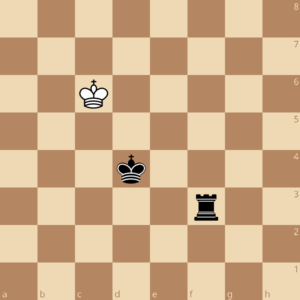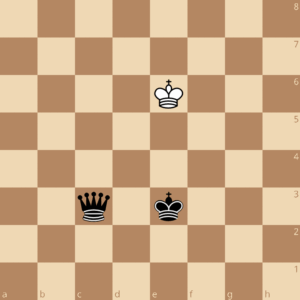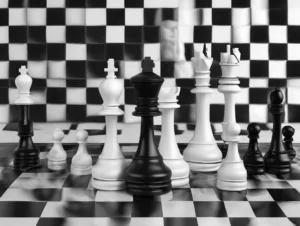I had 11 great moves in one game in chess.com! Can you imagine that 8 of those 11 moves came in the endgame. To be precise, it happened in a pawn endgame, where I could easily draw the game with my endgame knowledge. I reckon my opponent was sure that he would not be able to convert it to a win and here comes the twist, my opponent resigned! I won a game in a position that was supposed to be a complete theoretical draw. If you notice one thing that, I won the game because I knew the “trick”, and the other lost because his lack of knowledge of the “trick”. It is the basics of pawn endgames that helped me that day.
Pawns, when compared to other pieces, are considered to be of relatively lesser importance throughout almost the entire duration of a standard game of chess. A pawn is worth 1 point, the lowest among all pieces. However, pawns can be helpful in the middle game phase, and it becomes an inevitable part of endgames. As pawns reach the 8th or the 1st rank, its value becomes greater, i.e. it can promote to any higher value piece (e.g. knight, bishop, rook, king), except the king of course! 😅
Often, the endgame consists of only pawns, especially in games between beginner and intermediate players. It is very important to know how you would approach those remaining pawns with your king in order to convert your current position to a win, or a draw sometimes. Hence today’s topic comes into play; the Pawn Endgame. Let’s start with the basics.
The Basics of Pawn Endgames
There are lots of pawn endgame theories out there. Do you need to learn all of them? Well, it would be great for you. But we can just get started with the most basic one today.
We have a simple position below, where the white king has a pawn, and the black king is alone on the board. White will be trying to promote his pawn into a higher value piece to win the game. In such cases the queen and the rooks are the most popular options to pick. And black will try to defend so that the opposition cannot promote.
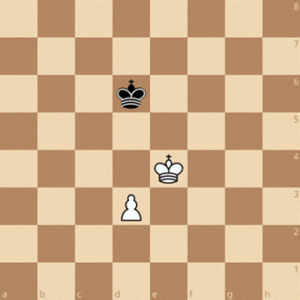
Note: When you are an attacking side in a king and pawn endgame, try to place your king ahead of the pawn all the time. It makes the win easier. But when the king is side-by-side or behind the promoting pawn, it could be a draw if opponent plays the best moves. Therefore, keeping your king ahead of the pawn is much safer.
So, what are you planning to play as white in this position?
The Opposition
Here comes another crucial idea. The Opposition! When your king is right in front of the other in just an interval of one square, that is what we call the opposition. As many other endgame theories, opposition is extremely important here too.
You should take the opposition as soon as you get the opportunity to. You must have guessed the move by now. It’s king to d4. You just simply take the valuable opposition.
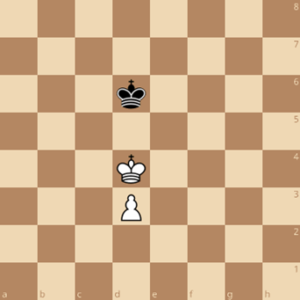
The position looks just like this, with both kings having a face-off to each other. Black must move the king somewhere. Let’s say he moves the square e6.
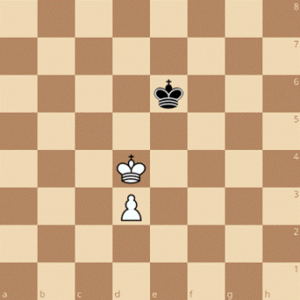
Outflank
Black went to the right direction from white’s point of view. What you must do now is to recall what is the opposite of right. It’s left obviously. You should go the opposite direction to what your opponent went to. It is left, in this case. Now the question is which square?
Your king should be moving forward as well. while moving in the opposite direction of the opponent’s king. Both the conditions will be met only if the white king goes to c5.
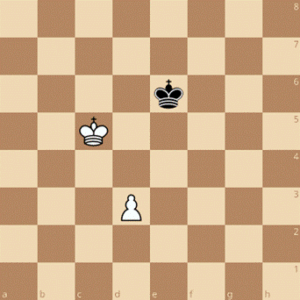
What you just did is called outflanking your opponent. Notice that white king occupies three squares in front of him, which black king can never reach. This is the advantage of outflanking in pawn endgames. Your pawn is now safe for at least three squares ahead of it. But don’t just push yet.
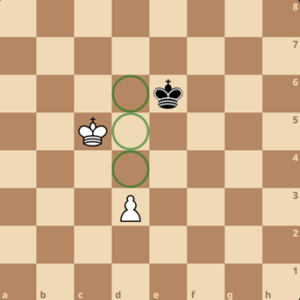
Black king will obviously still try to stop the promotion to save the day. Or he could hope white plays the wrong move! We cannot let that happen, right? Black continues to fight and plays the king to d7. Now you get the exact position as below.
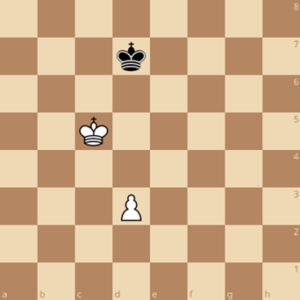
Repeat the Process
We now have a similar position compared to what we started off with. Except for the fact the white king is on the left side of the pawn. It doesn’t matter. The principle remains the same. Recall the first step, TAKE OPPOSTION when you get the chance.
Note: Do not push the pawn yet. Otherwise, it would be a draw if black plays it correctly. Black then would only have to ensure that he has opposition and he controls the square of promotion.
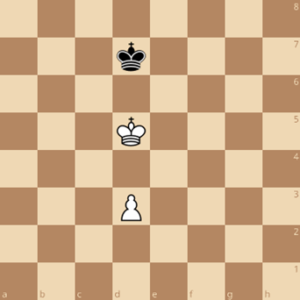
As soon as you take the faceoff to the opposite king, aka the opposition, you don’t allow black to move towards you. It is annoying for black and advantageous for white. The defending side has no choice but to move to the edge of the board and help making a safe path to the pawn promotion. Black moves to e7.
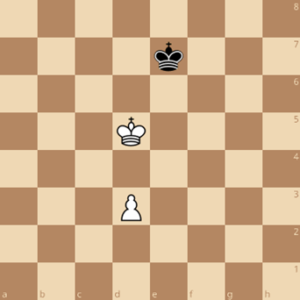
We outflank again by keeping our king c6. And finally, we have reached a crucial rank in a pawn endgame — the 6th rank.
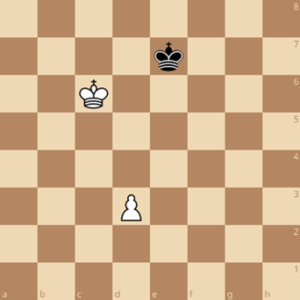
When you are the attacking side in a pawn endgame and your king sits on the 6th rank, you can pretty sure that your opponent now has nothing much to do, and you win the game in a few moves.
Black tries to get closer to our pawn in the position we are dealing with. It doesn’t actually matter anymore. We push our pawn anyway!
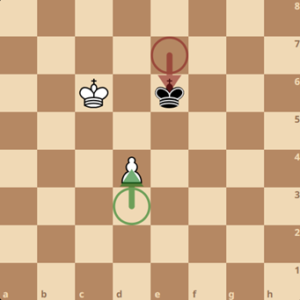
It is only a matter of time before we achieve victory in this game. We push our pawn once again, and the black king moves back to e7. We push the pawn to d5. King goes to d8 to control the promoting square for the last time.
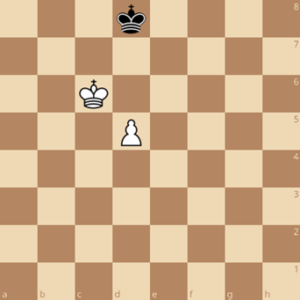
Things are progressing smoothly, just as our principles; Take Opposition and Outflank! Now we are left with the exact same position as the picture shows. White is completely in a winning position. But that is not enough. You have to perform one of the hardest tasks in chess, that is, to convert a winning position into a win.
You may want to push the pawn one step forward by instinct to bring a queen to the board. But unfortunately, that would lead to a theoretical draw! It creates a whole other scenario that is worth studying separately.
You must go against your appetite to play pawn to d6, and TAKE OPPOSITION! Kd6 is the only winning move in this position for white.
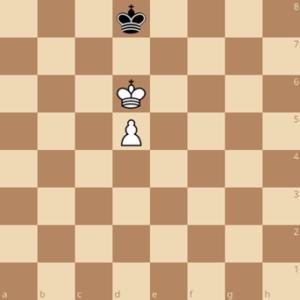
Black king is now forced to go to either e8 or c8. What do you do next? Try to remember both principles you learned today. You just applied one of them. Only the final outflanking remains, marking the last instance of this tactic in the game.
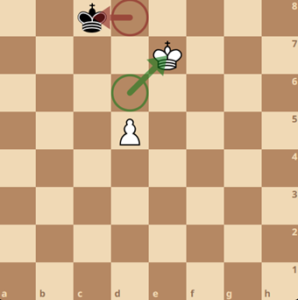
The red carpet for our pawn is ready to make an upgrade to the pawn into something more valuable, perhaps a queen. And I am sure you know how to checkmate a lone king with your royal pair of pieces!
Conclusion
This was the most basic form of a pawn endgame. There are a lot more variations available of the same pawn and king endings; the rule of the square, pawn on the 6th rank, rook’s pawn and so one. I consider learning this ending first to be beneficial for a better understanding of the rest of the variations. This will accelerate your grasp of the remaining position of a pawn ending. I will bring you some more pawn endgame scenarios soon! Stay tuned!


